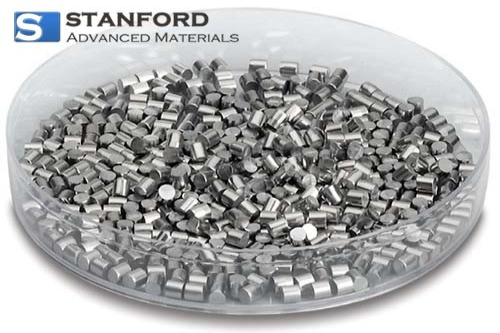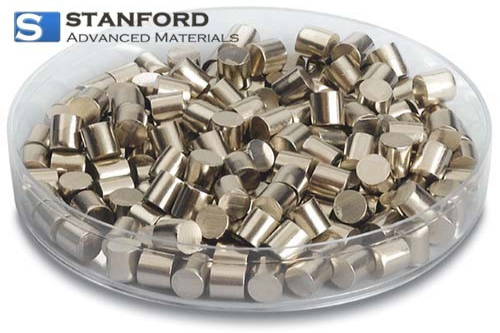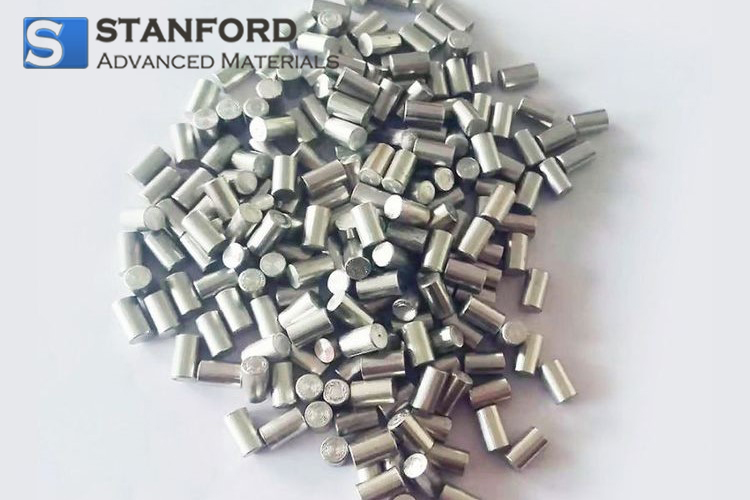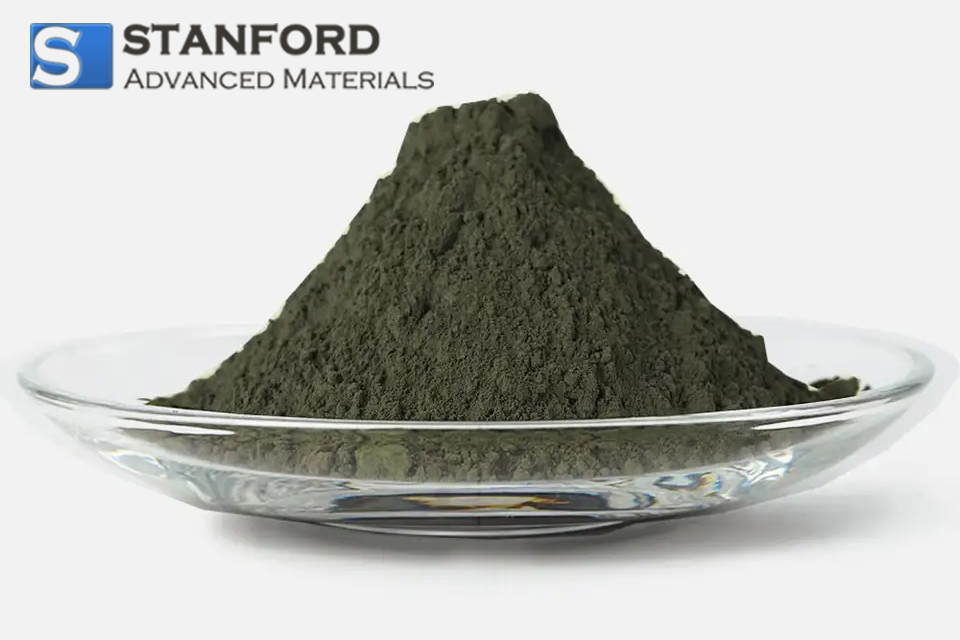SECTION 1. IDENTIFICATION
Product Name: Manganese Sulfide
CAS #: 18820-29-6
Relevant identified uses of the substance: Scientific research and development
Supplier details:
Stanford Advanced Materials
E-mail: sales@samaterials.com
Tel: (949) 407-8904
Address: 23661 Birtcher Dr., Lake Forest, CA 92630 U.S.A.
SECTION 2. HAZARDS IDENTIFICATION
2.1 Classification of the substance or mixture
GHS Classification in accordance with 29 CFR 1910 (OSHA HCS)
Skin irritation (Category 2), H315
Eye irritation (Category 2A), H319
Skin sensitisation (Category 1), H317
Acute aquatic toxicity (Category 2), H401
Chronic aquatic toxicity (Category 2), H411
For the full text of the H-Statements mentioned in this Section, see Section 16.
2.2 GHS Label elements, including precautionary statements
Pictogram
Signal word Warning
Hazard statement(s)
H315 Causes skin irritation.
H317 May cause an allergic skin reaction.
H319 Causes serious eye irritation.
H411 Toxic to aquatic life with long lasting effects.Precautionary statement(s)
P261 Avoid breathing dust/ fume/ gas/ mist/ vapours/ spray.
P264 Wash skin thoroughly after handling.
P272 Contaminated work clothing should not be allowed out of the workplace.
P273 Avoid release to the environment.
P280 Wear protective gloves/ eye protection/ face protection.
P302 + P352 IF ON SKIN: Wash with plenty of soap and water.
P305 + P351 + P338 IF IN EYES: Rinse cautiously with water for several minutes. Remove
contact lenses, if present and easy to do. Continue rinsing.
P333 + P313 If skin irritation or rash occurs: Get medical advice/ attention.
P337 + P313 If eye irritation persists: Get medical advice/ attention.
P362 Take off contaminated clothing and wash before reuse.
P391 Collect spillage.
P501 Dispose of contents/ container to an approved waste disposal plant.
2.3 Hazards not otherwise classified (HNOC) or not covered by GHS - none
SECTION 3. COMPOSITION/INFORMATION ON INGREDIENTS
Substances
Formula : MnS
Molecular weight : 87.00 g/mol
CAS-No. : 18820-29-6
EC-No. : 242-599-3
SECTION 4. FIRST AID MEASURES
Description of first aid measures
General advice
Consult a physician. Show this safety data sheet to the doctor in attendance.Move out of dangerous
area.
If inhaled
If breathed in, move person into fresh air. If not breathing, give artificial respiration. Consult a
physician.
In case of skin contact
Wash off with soap and plenty of water. Consult a physician.
In case of eye contact
Rinse thoroughly with plenty of water for at least 15 minutes and consult a physician.
If swallowed
Never give anything by mouth to an unconscious person. Rinse mouth with water. Consult a physician.
4.2 Most important symptoms and effects, both acute and delayed
The most important known symptoms and effects are described in the labelling (see section 2.2)
and/or in section 11
4.3 Indication of any immediate medical attention and special treatment needed
No data available
SECTION 5. FIREFIGHTING MEASURES
Extinguishing media
Suitable extinguishing media
Dry powder Dry sand5.2 Special hazards arising from the substance or mixture
No data available
5.3 Advice for firefighters
Wear self-contained breathing apparatus for firefighting if necessary.
5.4 Further information
No data available
SECTION 6. ACCIDENTAL RELEASE MEASURES
Personal precautions, protective equipment and emergency procedures
Wear respiratory protection. Avoid dust formation. Avoid breathing vapours, mist or gas. Ensure
adequate ventilation.
Avoid breathing dust.
For personal protection see section 8.
6.2 Environmental precautions
Prevent further leakage or spillage if safe to do so. Do not let product enter drains. Discharge into the
environment
must be avoided.
6.3 Methods and materials for containment and cleaning up
Pick up and arrange disposal without creating dust. Sweep up and shovel. Do not flush with water.
Keep in suitable,
closed containers for disposal.
6.4 Reference to other sections
For disposal see section 13.
SECTION 7. HANDLING AND STORAGE
Precautions for safe handling
Avoid contact with skin and eyes. Avoid formation of dust and aerosols.Further processing of solid
materials may result in
the formation of combustible dusts. The potential for combustible dust formation should be taken into
consideration before additional processing occurs.
Provide appropriate exhaust ventilation at places where dust is formed.
For precautions see section 2.2.
7.2 Conditions for safe storage, including any incompatibilities
Keep container tightly closed in a dry and well-ventilated place.
Never allow product to get in contact with water during storage. Do not store near acids.
Air sensitive. Keep in a dry place.
7.3 Specific end use(s)
Apart from the uses mentioned in section 1.2 no other specific uses are stipulated
SECTION 8. EXPOSURE CONTROLS/PERSONAL PROTECTION
Exposure controls
Appropriate engineering controls
Handle in accordance with good industrial hygiene and safety practice. Wash hands before breaks
and at the end of workday.
Personal protective equipment
Eye/face protection
Face shield and safety glasses Use equipment for eye protection tested and approved underappropriate government standards such as NIOSH (US) or EN 166(EU).
Skin protection
Handle with gloves. Gloves must be inspected prior to use. Use proper glove removal technique
(without touching glove's outer surface) to avoid skin contact with this product. Dispose of
contaminated gloves after use in accordance with applicable laws and good laboratory practices.
Wash and dry hands.
Body Protection
Complete suit protecting against chemicals, The type of protective equipment must be selected
according to the concentration and amount of the dangerous substance at the specific workplace.
Respiratory protection
Where risk assessment shows air-purifying respirators are appropriate use a full-face particle
respirator type N100 (US) or type P3 (EN 143) respirator cartridges as a backup to engineering
controls. If the respirator is the sole means of protection, use a full-face supplied air respirator. Use
respirators and components tested and approved under appropriate government standards such as
NIOSH (US) or CEN (EU).
SECTION 9. PHYSICAL AND CHEMICAL PROPERTIES
Information on basic physical and chemical properties
a) Appearance Form: powder
Colour: green
b) Odour No data available
c) Odour Threshold No data available
d) pH No data available
e) Melting point/freezing point
Melting point/range: 449.85 °C (841.73 °F)
f) Initial boiling point and boiling range
No data available
g) Flash point 280 °C (536 °F) at ca.1,013 hPa (760 mmHg)
h) Evaporation rate No data available
i) Flammability (solid, gas) No data available
j) Upper/lower flammability or explosive limits
No data available
k) Vapour pressure No data available
l) Vapour density No data available
m) Relative density 3.99 g/cm3 at 22.5 °C (72.5 °F)
n) Water solubility 0.006 g/l at 20 °C (68 °F) - slightly soluble
o) Partition coefficient: noctanol/
water
No data available
p) Auto-ignition temperature
ca.380 °C (716 °F) at 1,013 hPa (760 mmHg)
q) Decomposition temperature
No data available
r) Viscosity No data available
s) Explosive properties No data available
t) Oxidizing properties No data available
9.2 Other safety information
No data available
SECTION 10. STABILITY AND REACTIVITY
10.1 Reactivity
No data available
10.2 Chemical stability
Stable under recommended storage conditions.
10.3 Possibility of hazardous reactions
No data available
10.4 Conditions to avoid
No data available
10.5 Incompatible materials
Strong oxidizing agents, acids
10.6 Hazardous decomposition products
Hazardous decomposition products formed under fire conditions. - Sulphur oxides,
Manganese/manganese oxides
Other decomposition products - No data available
In the event of fire: see section 5
SECTION 11. TOXICOLOGICAL INFORMATION
11.1 Information on toxicological effects
Acute toxicity
LD50 Oral - Rat - female - > 2,000 mg/kg
(OECD Test Guideline 420)
LC50 Inhalation - Rat - male and female - 4 h - > 5.34 mg/l
(OECD Test Guideline 403)
Dermal: No data available
No data available
Skin corrosion/irritation
Skin - EPISKIN Human Skin Model Test
Result: Irritating to skin.
Serious eye damage/eye irritation
Respiratory or skin sensitisation
- Mouse
Result: May cause sensitisation by skin contact.
(OECD Test Guideline 429)
Germ cell mutagenicity
No data available
Carcinogenicity
IARC: No component of this product present at levels greater than or equal to 0.1% is identified as
probable, possible or confirmed human carcinogen by IARC.
NTP: No component of this product present at levels greater than or equal to 0.1% is identified as a
known or anticipated carcinogen by NTP.
OSHA: No component of this product present at levels greater than or equal to 0.1% is identified as a
carcinogen or potential carcinogen by OSHA.
Reproductive toxicity
No data available
No data available
Specific target organ toxicity - single exposure
No data available
Specific target organ toxicity - repeated exposure
No data available
Aspiration hazardNo data available
Additional Information
RTECS: Not available
Men exposed to manganese dusts showed a decrease in fertility. Chronic manganese poisoning
primarily involves the central nervous system. Early symptoms include languor, sleepiness and
weakness in the legs. A stolid mask-like appearance of the face, emotional disturbances such as
uncontrollable laughter and a spastic gait with tendency to fall in walking are findings in more
advanced cases. High incidence of pneumonia has been found in workers exposed to the
dust or fume of some manganese compounds., To the best of our knowledge, the chemical, physical,
and toxicological properties have not been thoroughly investigated.
Stomach - Irregularities - Based on Human Evidence
Stomach - Irregularities - Based on Human Evidence
SECTION 12. ECOLOGICAL INFORMATION
12.1 Toxicity
Toxicity to fish semi-static test LC50 - Oncorhynchus mykiss (rainbow trout) - > 13 mg/l - 96 h
(OECD Test Guideline 203)
semi-static test NOEC - Oncorhynchus mykiss (rainbow trout) - 7.8 mg/l - 96 h
(OECD Test Guideline 203)
Toxicity to daphnia and
other aquatic
invertebrates
static test EC50 - Daphnia magna (Water flea) - > 6.1 mg/l - 48 h
(OECD Test Guideline 202)
static test NOEC - Daphnia magna (Water flea) - > 6.1 mg/l - 48 h
(OECD Test Guideline 202)
Toxicity to algae static test EC50 - Desmodesmus subspicatus (Scenedesmus subspicatus) - 4.9
mg/l - 72 h
(OECD Test Guideline 201)
static test NOEC - Desmodesmus subspicatus (Scenedesmus subspicatus) -
2.6 mg/l - 72 h
(OECD Test Guideline 201)
Toxicity to bacteria EC50 - activated sludge - > 1,000 mg/l - 3 h
(OECD Test Guideline 209)
NOEC - activated sludge - 1,000 mg/l - 3 h
(OECD Test Guideline 209)
12.2 Persistence and degradability
No data available
12.3 Bioaccumulative potential
No data available
12.4 Mobility in soil
No data available
12.5 Results of PBT and vPvB assessment
PBT/vPvB assessment not available as chemical safety assessment not required/not conducted
12.6 Other adverse effects
An environmental hazard cannot be excluded in the event of unprofessional handling or disposal.
Toxic to aquatic life with long lasting effects.
SECTION 13. DISPOSAL CONSIDERATIONSWaste treatment methods
Product
Offer surplus and non-recyclable solutions to a licensed disposal company. Contact a licensed
professional waste disposal service to dispose of this material.
Contaminated packaging
Dispose of as unused product.
SECTION 14. TRANSPORT INFORMATION
DOT (US)
Not dangerous goods
IMDG
UN number: 3077 Class: 9 Packing group: III EMS-No: F-A, S-F
Proper shipping name: ENVIRONMENTALLY HAZARDOUS SUBSTANCE, SOLID, N.O.S.
(Manganese(II) sulfide)
Marine pollutant:yes
IATA
UN number: 3077 Class: 9 Packing group: III
Proper shipping name: Environmentally hazardous substance, solid, n.o.s. (Manganese(II) sulfide)
Further information
EHS-Mark required (ADR 2.2.9.1.10, IMDG code 2.10.3) for single packagings and combination
packagings containing inner packagings with Dangerous Goods > 5L for liquids or > 5kg for solids.
SECTION 15. REGULATORY INFORMATION
SARA 302 Components
No chemicals in this material are subject to the reporting requirements of SARA Title III, Section 302.
SARA 313 Components
The following components are subject to reporting levels established by SARA Title III, Section 313:
Manganese(II) sulfide
CAS-No.
18820-29-6
Revision Date
2007-07-01
SARA 311/312 Hazards
Acute Health Hazard, Chronic Health Hazard
Massachusetts Right To Know Components
No components are subject to the Massachusetts Right to Know Act.
Pennsylvania Right To Know Components
Manganese(II) sulfide
CAS-No.
18820-29-6
Revision Date
2007-07-01
Manganese(II) sulfide
CAS-No.
18820-29-6
Revision Date
2007-07-01
New Jersey Right To Know Components
Manganese(II) sulfideCAS-No.
18820-29-6
Revision Date
2007-07-01
California Prop. 65 Components
This product does not contain any chemicals known to State of California to cause cancer, birth
defects, or any other reproductive harm.
SECTION 16. OTHER INFORMATION
Safety Data Sheet according to Regulation (EC) No. 1907/2006 (REACH). The above information is
believed to be correct but does not purport to be all inclusive and shall be used only as a guide. The
information in this document is based on the present state of our knowledge and is applicable to the
product with regard to appropriate safety precautions. It does not represent any guarantee of the
properties of the product.











